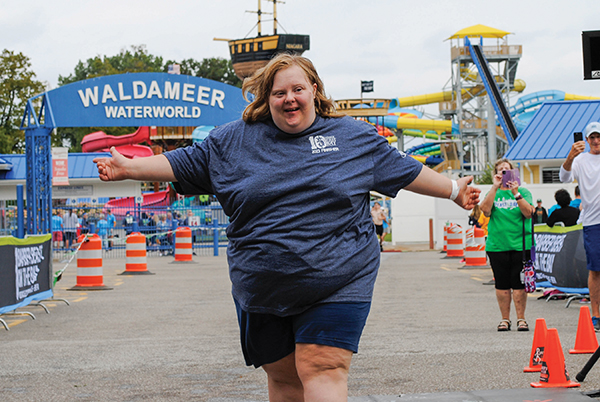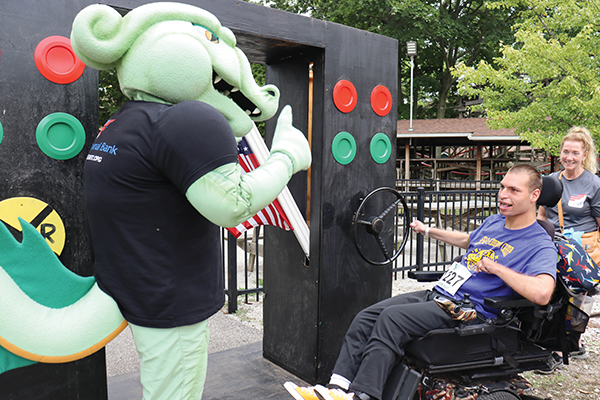Obstacle course races and mud runs have increased in popularity in the past decade. But there's only one event in the country that has a one-mile adapted course for adults with intellectual disabilities and a finish line that coincides with the event's 10-mile course, so that the two courses meet up for a final obstacle and all participants cross the finish line together.
That event is the Barber Beast on the Bay, held at Presque Isle State Park in Erie, Pennsylvania, which marked its 10th anniversary September 2023 and it has some lessons to teach all event owners who would like to create more accessible, welcoming competitions.
The Barber Beast on the Bay is a signature event of the Barber National Institute, a nonprofit organization that provides programs and services for adults and children with intellectual disabilities, autism and behavioral health needs. The Barber National Institute serves more than 5,400 individuals across Pennsylvania.

“We started the Barber Beast on the Bay 10 years ago, as a visible example of our belief that all people must be afforded every opportunity to attain the greatest use of their potential,” reflected Barber National Institute President and CEO John Barber. “This is one of the things that is so special about our event and something that participants say is gratifying about our finish. It speaks to how everyone is striving to overcome obstacles and enables us to celebrate these achievements together.”
Barber had the idea for the event when his trainer, Lisa Oberacher Hilinski, returned from an obstacle run. “I felt that we could create an event that would challenge the entire community and feature our individuals.”
The Beast’s adapted course was the creation of Barber National Institute Elizabeth Lee Black School educator Lindsay Kalika who had a brother with intellectual disabilities.
“In the beginning, it was Lindsay who brought the adapted course to life. She designed the adapted course to be challenging for the participants because she wanted them to believe they could do it,” said Laura Schaaf, director of giving for the Barber National Institute. “She gathered local contractors to design and build the adapted obstacles.”
Presque Isle State Park’s Beach 1 was the original location for the adapted course, which was separated from the 10-mile course.
“Ten-mile participants would pass through the adapted course not realizing what was going on,” said Schaaf.
A phone call from Paul Nelson, owner of Erie’s premier amusement park Waldameer and Water World, eventually relocated the adapted course and merged the two courses into one final obstacle and finish line.
“From the beginning, Waldameer and Water World hosted the afterparty for all participants. But, one day, the owner had an idea to completely move the adapted course to the amusement park, join the two courses at its wave pool and create a shared finish line,” said Schaaf. “This was a pivotal decision that provided the opportunity to fully integrate the two courses.”
Dr. Brian Stark has completed the Beast on the Bay all 10 years.
“The Beast on the Bay is a unique and fun experience, but it’s also a challenging long-distance athletic event. It’s not easy to finish. Inevitably, you start thinking about the special-needs adults and children who benefit from this fundraising event, and it helps you dig deep and push on,” said Stark. “When the two courses merge, suddenly, the sweat, sand, fatigue and pain fade away. It’s then I remember how much the Institute does and how much my participation matters.”
The Beast’s obstacles are conceptualized and built by a team of “beast builders,” who collaborate with Barber National Institute Elizabeth Lee Black School’s physical education teacher to create new or modify existing adapted obstacles.
According to Schaaf, “The builders spend hours batting around ideas to reimagine and craft the obstacles. They look at an obstacle and start talking about what if it moves this way, or you go over it instead of around it; they are very analytical and mathematical.”
For beast builder Andy Zimmerman, there is much to consider when designing the adaptive course. He says it is essential to consider sensory stimulants, strength levels, sight lines, obstacle sequence and mobility, noting, “We avoid flashing lights and loud sounds. We must consider the structural integrity of the obstacle, wheelchair accessibility, differing eyesight levels, strength of the participants and the experience.”
Zimmerman stresses the importance of a team that trusts one another and is diverse in technical background and expertise.
“A very good team must be able to openly discuss ideas, have differing backgrounds and be mechanically inclined. We meet a couple of times to review ideas before starting fabrication. We inspect and repair existing obstacles and spend hours developing new ones. The team must be able to work together and have fun.” And, Zimmerman adds, “Hot heads never prevail, and an argument must be over in 30 seconds! In all seriousness, our purpose is to create memorable moments for the participants and our team is the best.”
For event organizers considering including adapted aspects into events, Schaaf advises adding content experts to the event team. “Team members with varying skill sets and expertise give us a perspective of what is needed to create an inclusive event. They are very skillful and creative, taking obstacles and tweaking them to work differently. In a way, the obstacles are reflections of the participants, each offering something unique.”
Schaaf recommends building obstacles early, testing them with individuals with disabilities and keeping it simple. “Don’t try to do too much. It’s easy to let our creativity drive our obstacle development. Our most beloved obstacle features pool noodles hanging in a container as participants shimmy their way to high-energy music. This simple obstacle builds participants’ confidence and enthusiasm early.”
The thriving Beast engages community organizations and universities in hosting cheer zones, volunteering and raising money. All Beast proceeds are directed to the Barber National Institute’s foundation. In total, the Beast has raised over $700,000 since its inception in 2013.
“For our 10th anniversary event, we directed over $100,000 in proceeds for an important therapeutic pool renovation project.”
The Erie Sports Commission has been a valued partner since the event’s inception, providing marketing and communications strategy, matching funds and logistical support.

“The Barber Beast on the Bay has evolved into one of the most impactful events that we support annually,” said Mark Jeanneret, executive director of the Erie Sports Commission. “We are extremely fortunate to have a team of talented individuals at the Institute who work together to execute an event that stretches light years beyond our mission. Not only does the Beast consistently attract participants from across the country, but it also embraces its mission to provide an opportunity for everyone to overcome whatever obstacle they may be facing.”
Schaaf stresses the importance of getting annual feedback. “A survey helps us look through the eyes of our stakeholders. We use the survey results to enhance the event experience, improve efficiencies and remain relevant in an ever-changing event landscape. When you’ve built a strong event reputation, corporate sponsors, volunteers and brands want to align themselves with your mission.”
Schaaf reflects, “Our individuals are at the center of our work. This event gives us a platform to demonstrate their abilities and dispel common misperceptions about people with disabilities. There’s a perception that an individual with disabilities can’t do something. The event helps community members understand you don’t have to do it for them; you can assist them on an as-needed basis and cheer them on. It’s about making sure that the individuals are successful.”
When asked to share what is most rewarding, Zimmerman says, hands down, it’s the participants. “Watching the participants is what brings me the greatest joy. Words will never express the pride I have for the builders, the Barber National Institute and all we’ve accomplished. This has always been a true labor of love for me.”
More information about the Barber Beast on the Bay is available at barberbeast.org. SDM

